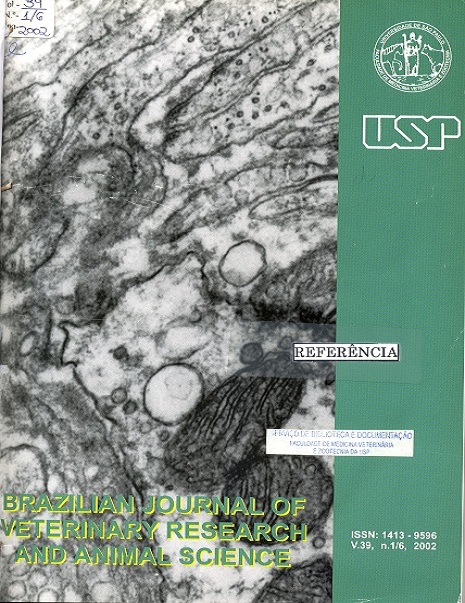Histochemical study of fibrillar proteins of the extracellular matrix in benign and malignant mammary neoplasms in dogs
DOI:
https://doi.org/10.1590/S1413-95962002000100008Keywords:
Mammary neoplasms, Collagen, Dogs, Extracellular matrixAbstract
The aim of the present study was to study some of the proteins that form the extracellular matrix of 54 benign and malignant mammary neoplasms in dogs, using histochemical methods: Picrosirius and polarization microscopy for collagenous fibers, Gordon -Sweats's method for reticular fibers and Weigert's fucsine-resorcine method for elastic fibers. A large variability in quantity, distribution and characteristics of the matrix components was observed in the different types of neoplasms. Collagen type I, III and elements of the elastic system had different distribution in benign and malignant neoplasms. The simple Picrossirius method and under polarization enabled visualization of collagen as thick fibers irregularly distributed in the stroma of carcinomas and in a more orderly and regular fashion in benign neoplasms. A smaller amount of thin fibers was observed in an irregular and random disposition in carcinomas and in a regular disposition in benign neoplasms . Under polarization, the fibers present different lengths, were yellowish or reddish and strongly birefringent, what suggested that they were collagen type I and in the middle of these fibers, other ones, pale, greenish and weakly birefringent, some of them thinner, possibly collagen type III were observed. In the stroma of carcinoma, fibers were mostly thick, strongly birefringent, yellowish or reddish, disposed in an irregular and random fashion, mainly in the central areas. In condrometaplasic areas, both in malignant and benign neoplasms, there was a collagen population composed by thin fibers in a parallel disposition, limiting narrow regions where condrocytes were aligned. Around this area, there was a collagen population formed by bundles of thick anastomosed fibers, irregularly disposed in carcinomas and orderly, in a parallel fashion in benign neoplasms. Under polarization demonstrated that this population, among condrocytes, was formed by weakly birefringent fibers, pale and yellowish, what suggested a collagen type II pattern. The use of reticular fibers staining by Gordon & Sweats, enabled a visualization of collagen as thin fibers disposed not only in the dense stromas but also in the loose ones. These fibers presented variable density, but were found mainly around acini and tubules. In relation to the presence elements of the elastic system in benign and malignant tumors, it may be observed that they predominate in the malignant ones, mainly in the pseudocapsule and around acini and tubules. Elements of the elastic system were not observed in the specimens when they were submitted to Weigert's staining without oxidation. When the same material was submitted to Weigert's staining with oxidation , oxytalan fibers were more evidently around acini and tubules, as well as in the pseudocapsule. Elements of the elastic system were in the ECM, both in samples submitted to staining with oxidation and without it and this was similar for benign and malignant tumors. Results of this study emphasize the profound structural changes in collagenous and fibrous components of the extracellular matrix elastic system of mammary neoplasms in dogs.Downloads
Download data is not yet available.
Downloads
Published
2002-01-01
Issue
Section
UNDEFINIED
License
The journal content is authorized under the Creative Commons BY-NC-SA license (summary of the license: https://
How to Cite
1.
Martins AMCRP da F, Tamaso E, Guerra JL. Histochemical study of fibrillar proteins of the extracellular matrix in benign and malignant mammary neoplasms in dogs. Braz. J. Vet. Res. Anim. Sci. [Internet]. 2002 Jan. 1 [cited 2026 Jan. 17];39(1):43-9. Available from: https://revistas.usp.br/bjvras/article/view/5938





